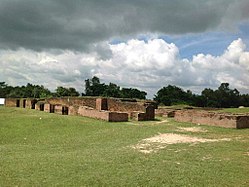Bangarh
 Bangarh, Gangarampur | |
| Alternative name | Devkot, Kotivarsha, Devikota, Devakota, Diw-kot |
|---|---|
| Location | Gangarampur, West Bengal, India |
| Coordinates | 25°24′45″N 88°31′50″E / 25.41250°N 88.53056°ECoordinates: 25°24′45″N 88°31′50″E / 25.41250°N 88.53056°E |
| Type | Historical Place |
| History | |
| Founded | Earlier than 200 BC |
Bangarh is an ancient city situated in Gangarampur, West Bengal, India. Bangarh was the ancient city which was the administrative centre of Kotivarsha Vishaya (territorial division), itself part of the wider administrative unit of Pundravardhana Bhukti, which had Mahasthangarh as its capital[1] in the period of Chandras, Varmans and Senas. After the Senas were defeated by the Muslims under Bakhtiar Khilji, Devkot was established as their capital where Bakhtiar died.[2][full citation needed]
Geography[edit]
| Cities and towns in the Dakshin Dinajpur district M: municipal city/ town, CT: census town, R: rural/ urban centre, H: historical site Owing to space constraints in the small map, the actual locations in a larger map may vary slightly |
Location[edit]
Bangarh is located at 25°24′45″N 88°31′50″E / 25.41250°N 88.53056°E
In the map alongside, all places marked on the map are linked in the full screen version.
History[edit]
The earliest mentions about the Kotivarsha town are found in the Vayu Purana (XXIII,209) and the Brihat Samhita (XI, II). Lexicographers, Hemchandra (the Abhidhanachintamani IV,977) and Purushottama (in his Trikandashesha) have mentioned the city by several names – Uma(Usha?)vana, Banapura, and Shonitapura. Sandhyakara Nandi in his Ramacharita described at length about the temples and the lakes of the city.[3] The ruins of the city are found in Bangarh, which is located at Gangarampur city, about 45 km south of Balurghat city, in Dakshin Dinajpur district of West Bengal state in eastern India. It has variously thought of as part of Pundravardhana or Rarha regions.[4] There was a Brahmin densities at Devikota.[5]
Muslim rule was first established in Bengal in 1204 by Bakhtiyar Khilji. The kingdom was called Lakhnawati or Lakhnauti. The capital was located sometimes at Lakhnawati and sometimes at Devkot. Bakhtiyar Khilji died at Devkot in 1205–06, possibly murdered by Ali Mardan, who was governor of Naran-Koh,[6] although this account is deemed erroneous by most Historians and it is established that Bakhtiyar died as a result of the physical wounds and mental trauma he endured from his unsuccessful trip to Tibet which was essentially cut short in northern Assam.[7]
Excavations at Bangarh[edit]
The earliest excavations at Bangarh was carried out by a team led by K.G. Goswami during 1938–41. Located on the bank of the Punarbhaba, the excavated site reflects its urban character. The site has its core in the form of a citadel surrounded by mud ramparts (area about 25 hectares) which dates from the earliest phase of the site. The earliest phase remains uncertain, as the excavations could not reach the natural soil.[1] The citadel area revealed five cultural phases dating from the time of the Mauryas to the medieval period. The initial phase (the Mauryan period) indicates that the city had a modest beginning in which it had probably a mud rampart wall. It was only in the following phase (the Kushana period, 200 BCE - 300 CE) a brick built wide rampart wall is found with drains, cesspits and residential buildings made of burnt bricks of a very large size, showing distinct signs of prosperity and burgeoning urbanism. The excavated materials of the Gupta period are not comparable with the richness and diversity of those belonging to Kushana cultural phase. Though the late Gupta phase of Bangarh is marked by decadence, particularly in terms of building activities, the Pala period (mid 8th century -12th century), in sharp contrast, indicates a picture of efflorescence. Rampart walls, compound walls, residential quarters, temples with ambulatory path and its enclosing walls, damp proof granaries, bathrooms, drains and ring wells suggest a prosperous condition of the city.[8]
References[edit]
- ↑ 1.0 1.1 Chakrabarti, Dilip K. (2006, reprint 2007). Relating History to the Land in Patrick Oleville (ed.) Between the Empires: Society in India 300 BCE to 400 CE, New York: Oxford University Press, ISBN 0-19-568935-6, p.9
- ↑ M M Ali, History of Muslims in Bengal
- ↑ Roy, Niharranjan (1993). Bangalir Itihas: Adiparba (in Bengali), Calcutta: Dey's Publishing, ISBN 81-7079-270-3, p.301
- ↑ Majumdar, Dr. R.C., History of Ancient Bengal, First published 1971, Reprint 2005, p. 10, Tulshi Prakashani, Kolkata, ISBN 81-89118-01-3.
- ↑ Majumdar, Dr. R.C., p. 457
- ↑ Majumdar, Dr. R.C., History of Mediaeval Bengal, First published 1973, Reprint 2006, pp. 3, 67, Tulshi Prakashani, Kolkata, ISBN 81-89118-06-4.
- ↑ Muhiddin Khan, Islam in Bangladesh
- ↑ "Eight eras of Indian history unearthed in Bangarh". The Telegraph. Calcutta. 14 May 2009. Retrieved 23 September 2009.
External links[edit]
Template:Non-extant Bengal places Template:Dakshin Dinajpur topics


